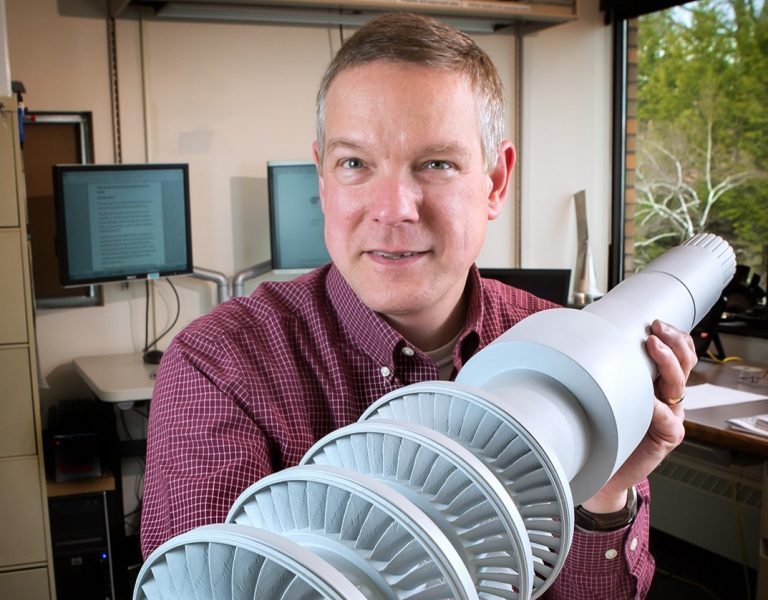HARNESSING CO2 FOR CLEANER ENERGY
Southwest Research Institute, in partnership with GE, recently started building the world’s first 10-megawatt power plant using supercritical carbon dioxide instead of steam. Supercritical CO2 refers to CO2 that exists at very high temperatures and pressures. It's dense like a liquid but expands like a gas to fill every available space inside the turbine. The supercritical CO2 will circulate through the plant system, pushing against the blades and turning the turbine.
Bad CO2, good CO2: The San Antonio plant will be the largest CO2 turbine ever built. The purpose of the new facility is to demonstrate that smaller CO2 turbines can scale up to industrial-size plants. Smaller pilot projects suggest supercritical CO2 turbines could be small enough to fit on a conference table and generate electricity at higher efficiency than steam-powered turbines. The team will look closely at half a dozen control variables that determine how efficiently the turbine is being run — things like the temperature of the CO2 as it enters the turbine, the pressure at key valves and the status of materials at key joints and seals. GE plans to start getting data from the new plant in 2020 and to finish collecting in 2022.
Read more about this groundbreaking project here.
AVITAS SYSTEMS ALLOWED TO WORK BEYOND LINE OF SIGHT
Drones have been a boon to inspectors and their clients, but they’ve come with one severe limitation: The Federal Aviation Administration, rightly cautious about drones wandering into the airspace of airplanes, requires drone pilots to keep the vehicle within their line of sight. That means a drone can’t go more than roughly 1 mile from its pilot. More recently, Congress instructed the FAA to create a process for companies to get their drones approved to inspect critical infrastructure from beyond the visual line of sight.
A longer leash for drones: In October, the FAA issued Avitas Systems, a GE Venture, a first-of-its-kind permit to operate a large drone beyond the visual line of sight. Avitas Systems uses autonomous and semi-autonomous drones to visually inspect customers’ industrial assets like oil wells, gas pipelines, power lines and other structures. Demonstrating the safety of Avitas Systems’ flight-management system was key to winning the exemption. “We showed [the Air Line Pilots’ Association] our safety plan, our use of radar and our ability to work with manned aviation traffic in the area,” said Michael Clatworthy, director of flight operations for Avitas Systems. “We made it clear that we want to play nicely.” Clatworthy expects the exemption to greatly enhance productivity.
Read more about Avitas Systems here.
FATHER-DAUGHTER DUO FIX GE PLANES IN KANSAS
Navy veteran Kenny Glasgow, 82, worked at the GE Aviation factory in Strother, Kansas for almost four decades. After active duty, he took a job in the maintenance department at GE and soared to a leadership position on classified work for the B-2 stealth bomber. He introduced his daughter, Kathryn, to planes while she was a child. When it was her turn to graduate from high school, she went straight to the plant. “I don’t know how to explain it, but I always knew that I wanted to work here,” Kathryn said.
Like father, like daughter: Kathryn is now finishing her 40th year at GE. Like her father, Kathryn started at the bottom and now leads a team that repairs engines for Apache and Black Hawk helicopters. Her father taught her how to fix airplanes, shape tools and find new solutions to problems. “He expected a lot,” she said. “He wanted you to know a lot.”
Read more about the Glasgow duo here.
COOLEST THINGS ON EARTH ?
1. Super Mario-inspired mushrooms
Scientists at Stevens Institute of Technology took an ordinary grocery-store mushroom and 3D-printed its surface with graphene nanoribbons and cyanobacteria, known to scientists for its ability to produce electricity. Cyanobacteria doesn’t live very well in the lab, but the team found the mushroom provided it with friendly conditions — nutrients, moisture and pH.
2. Regenerating frog limbs
Biologists at Tufts University designed a device that, by "kick-starting" tissue repair at the site of an injury, helps frogs regenerate bigger, more structured limbs than they otherwise would, said researcher Michael Levin. The bioreactor relies on progesterone, best known as the hormone that helps prepare the uterus for pregnancy but which also assists in the repair of nerves, blood vessels and bone tissue.
3 Brain-simulating computer
Scientists at the University of Manchester have just switched on a computer designed to mimic the human brain. The computer, dubbed Spiking Neural Network Architecture, took 20 years of planning and 10 years of construction. The researchers plan to use the network to run simulations to see, for instance, how neurons fire and to possibly better understand conditions like Parkinson’s disease.
Read more about this week’s Coolest Things here.
— QUOTE OF THE DAY —
“I remember spending weekends polishing [the Cessna 150]. It was our family time. My father swears that aviation is in our blood.”
— Kathryn Glasgow, GE employee for nearly 40 years
Quote: GE Reports. Image: Getty Images.
ENJOY THIS NEWSLETTER?
Please send it to your friends and let them know they can subscribe here.






